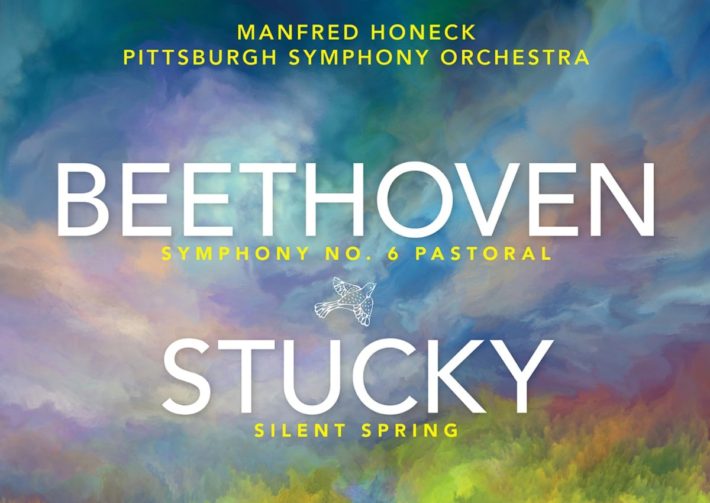The slowly evolving Pittsburgh/Honeck Beethoven symphony cycle has passed the mid-way point, with four symphonies, Nos. 1, 2, 4 and 8, yet to be released. Followers of this series know what to expect: brilliant orchestral execution, with tempos and orchestral sonorities partially rooted in historical period practice. And yet, at heart, Honeck is a romantic and his readings are strongly interpreted, with widely varying results. The technical elan and emotional power of his Eroica is stunning, but his ninth was a severe disappointment, in large part because of unnecessary alterations to Beethoven’s score. Regrettably, Honeck once again chooses to meddle with the score in his reading of the sixth.
Best to begin with the positive aspects of the recording – and there are plenty. Having recently listened to this orchestra’s 1960s Brahms symphony cycle under William Steinberg (recently released by DG), one can only marvel at the technical assurance and tonal splendor of the current Pittsburgh ensemble. The Pastorale’s many wind solos have abundant character and tonal allure (the flute and clarinet especially). The horns cover themselves in glory and the ensemble sound has tremendous power and precision. Dynamics are masterfully controlled. There is a consistent and intense emotional connection – these players never give anything less than their absolute best, a testament to their relationship with their conductor. They are clearly inspired by and believe in Honeck’s interpretative vision.
The opening movement’s tempos would raise the heart rate of most walkers, its energy infectious. The second movement, also played at an especially flowing tempo, is serenely beautiful, in contrast to the rustic rowdiness (listen to those fabulous horns!) of the Scherzo. The thunderstorm is harrowing (fabulous timpani playing), the final hymn of thanksgiving ideally paced and emotionally cathartic.
The above description would suggest this should be a new primary recommendation, but Honeck’s unconvincing and unnecessary score interventions are problematic. His extensive liner notes explain his reasoning for the changes, but we must remember Beethoven’s own comments about ‘programmatic’ music. The composer felt the listener should “discover the situations himself”, and that “(…)it is more feeling than tone-painting.” While Honeck acknowledges Beethoven’s statement in his notes, he argues that tone-painting “is absolutely a question of proportions,” and proceeds to rationalize changes to the score that increase its tone-painting.
Related Posts
- Beethoven – Symphony No. 6 – A Beginners Guide
- Review: Beethoven – Symphonies 6-9 – Le Concert des Nations, Jordi Savall
- Review: Beethoven – Complete Symphonies – Nézet-Séguin, Chamber Orchestra of Europe
The first change appears within the first minute of the opening movement (track 1, 0’43”) where the flute figure suggests bird song. Since this passage is difficult to hear within the busy orchestral texture, Honeck has a piccolo play the figure. Honeck is certainly not the first conductor to make these kinds of changes: George Szell, for one, added notes to the trumpet part in the Eroica, arguing that the trumpet of Beethoven’s time lacked the range to play the complete theme.But Honeck’s reasoning is not the same; his change turns the subtle suggestion of birdsong into a line that clearly stands out. In visual art terms, Honeck uses oil paint on Beethoven’s watercolor painting.
In the scherzo (track. 3, 1’41”) the flute line again suggests bird calls and once again Honeck reorchestrates the passage with a piccolo, arguing “The birds now become audible in their dance!” The trio is in a quick duple meter, with sforzandos on each downbeat – music that clearly paints an image of dancing. Yet Honeck feels the image is not obvious enough, so he asks his players to stomp their foot on every downbeat. While this may prove exciting and effective in a live performance, on repeated listening it becomes an annoyance.
The companion work, Stucky’s “Silent Spring” is beautifully played. The orchestra commissioned the work from Stucky to commemorate the 50th Anniversary of Rachel Carson’s book bearing the same title, which addresses humankind’s effect on nature and environment, a subject that is even more important today.The music is masterfully crafted, consonant with a liberal use of dissonance, embracing a kaleidoscopic range of orchestral colors and mercurial shift of mood. Reference’s recording of both works allows us to revel in the many glories of this fabulous orchestra.

Beethoven – Symphony No. 6 & Steven Stucky: Silent Spring
Pittsburgh Symphony Orchestra
Manfred Honeck – Conductor
Reference Recordings, CD FR-747
Recommended Comparisons
Read more classical music reviews or visit The Classic Review Amazon store
Follow Us and Comment:
[wd_hustle id=”HustlePostEmbed” type=”embedded”]











